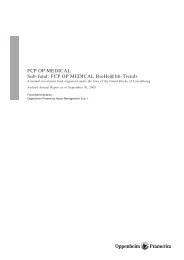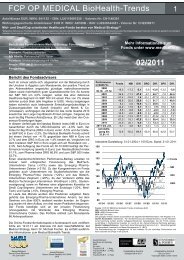FCP OP MEDICAL BioHealth-Trends - medical.lu
FCP OP MEDICAL BioHealth-Trends - medical.lu
FCP OP MEDICAL BioHealth-Trends - medical.lu
Create successful ePaper yourself
Turn your PDF publications into a flip-book with our unique Google optimized e-Paper software.
<strong>FCP</strong> <strong>OP</strong> <strong>MEDICAL</strong> <strong>BioHealth</strong>-<strong>Trends</strong> / Annual Report as of December 31, 2010<br />
Fundsreport<br />
<strong>FCP</strong> <strong>OP</strong> <strong>MEDICAL</strong> <strong>BioHealth</strong>-<strong>Trends</strong> is a healthcare fund<br />
for global investment that focuses on mid and small caps. Its<br />
objective is to outperform the indices over the long term by<br />
systematically concentrating on future high-growth markets<br />
in the healthcare industry. Given that product innovations in<br />
the pharmaceuticals industry and <strong>medical</strong> technology are<br />
among the most important growth drivers in the healthcare<br />
sector, the Fund primarily invests in young companies with<br />
business models built on innovation. The Fund especially<br />
targets companies with products that are soon to be released,<br />
new on the market or starting to be profitable. The Fund<br />
contains only a small proportion of companies with products<br />
in the relatively early stages of development.<br />
The investment focus is primarily on biotechnology firms<br />
that develop new drugs for illness currently lacking treatment<br />
or adequate treatment. Emerging pharmaceutical companies<br />
specialising in innovative preparations for specialty therapy<br />
areas represent another investment segment. In addition to<br />
the drug sector, the Fund also invests in <strong>medical</strong> technology,<br />
which offers many innovative product developments to<br />
improve diagnosis and therapy for a variety of disorders.<br />
Since small and mid cap stocks in the healthcare sector often<br />
display increased volatility (e.g. due to dependence on<br />
clinical results), the Fund controls company-specific risk by<br />
broadly spreading its investments over approximately 80<br />
positions.<br />
The Fund's investment style is oriented toward pure stock<br />
picking, without being tied to a benchmark. In this way, the<br />
Fund allows long-term investors to tap into the future<br />
potential of dynamic growth segments in the healthcare<br />
sector.<br />
Founded on 30 October 2000, <strong>FCP</strong> <strong>OP</strong> <strong>MEDICAL</strong><br />
<strong>BioHealth</strong>-<strong>Trends</strong> has now been on the market for more than<br />
ten years. Over this period, the Fund has outperformed both<br />
related healthcare and broader market indices (also see Fig.<br />
2, p.5). In addition, <strong>FCP</strong> <strong>OP</strong> <strong>MEDICAL</strong> <strong>BioHealth</strong>-<strong>Trends</strong><br />
recorded the top performance of +43.24 % in a 10-year<br />
comparison with other biotechnology funds, representing a<br />
lead of 53.8 % over the second place fund (Micropal peer<br />
group comparison of 15 biotechnology funds approved for<br />
distribution in Germany as at 30 December 2010, data in<br />
euros).<br />
Investment strategy during the reporting period<br />
General conditions and sector-specific events<br />
The economic recovery continued in most of the major<br />
industrialised countries in 2010, with support from expansive<br />
monetary and tax measures in the USA in particular. The<br />
global economy therefore offered a favourable environment<br />
for the equity markets, which were only temporarily<br />
impacted by the euro debt crisis in the second quarter. As a<br />
result, the broad market indices recorded increases, such as<br />
the 13 % increase in the S&P 500 and the 11 % increase in<br />
the Dow Jones Industrial (all data in US dollars).<br />
Since healthcare is a defensive sector, it remained<br />
significantly behind the broad market in this environment.<br />
This was also due to a number of sector-specific events, such<br />
as continuing revenue losses due to patent expirations in the<br />
pharmaceutical sector at the same time that research<br />
efficiency is declining, additional costs due to healthcare<br />
reforms, and price pressure from economising measures in<br />
the public budgets of many EU countries. Given these<br />
circumstances, the S&P 500 Healthcare Index HCX only<br />
achieved a gain of +1 %. This was the worst performance of<br />
all 10 sector sub-indices of the S&P 500. The main<br />
contributing factors were the underperformances in the Big<br />
Pharma (-3 %) and <strong>medical</strong> technology (-4 %) sub-segments.<br />
However, even the large cap biotechnology companies only<br />
achieved an increase of +1.9 % (relative to the S&P 500<br />
Healthcare sub-sectors). Only the highly diversified Nasdaq<br />
Biotechnology Index NBI (comprised of 130 securities)<br />
achieved performance comparable to the broad market,<br />
recording an increase of 15 %. Close to 8 % of this<br />
performance occurred in December, with a major<br />
contribution attributable to Intermune’s 145 % increase in<br />
va<strong>lu</strong>e due to an EU approval recommendation (all data in US<br />
dollars).<br />
In view of the sector-specific challenges, the largest<br />
companies in the sector, and Big Pharma in particular, find<br />
themselves in a comprehensive process of transformation<br />
(inc<strong>lu</strong>ding cost reductions, biotechnology integration and<br />
diversification), of which the success is still impossible to<br />
predict. The resulting scepticism of many investors led in the<br />
end to significant underperformance by the large drug<br />
manufacturers (Amex Pharmaceutical Index DRG in USD:<br />
-1 % in 2010). As a result, the va<strong>lu</strong>ations of Big Pharma<br />
companies are at historically low levels, with an average<br />
price-earnings ratio (based on expected earnings for 2011) of<br />
10.2 for US pharmaceutical companies and 11.0 for the EU<br />
(Jeffries, 11 January 2011).<br />
3





